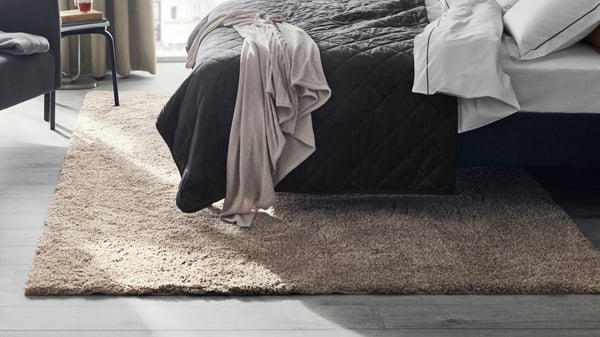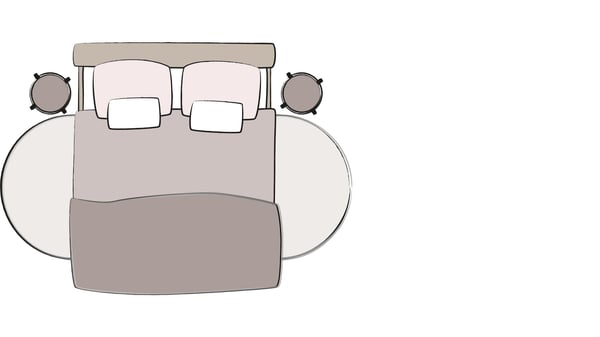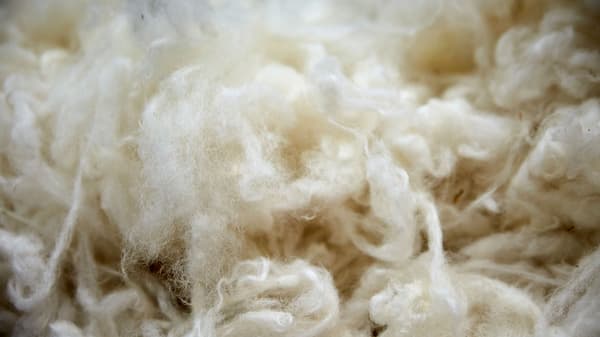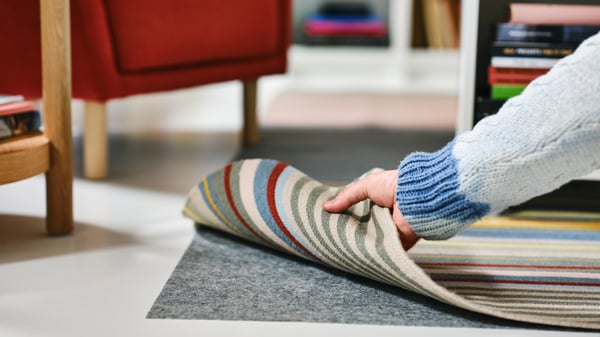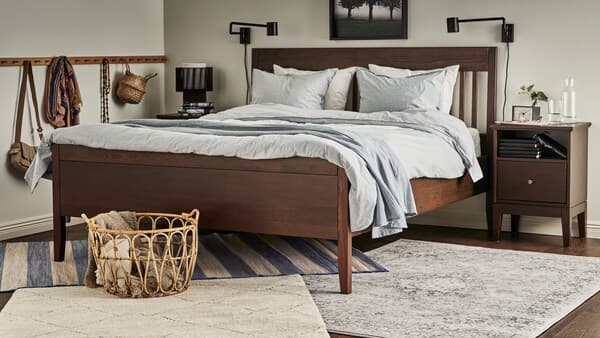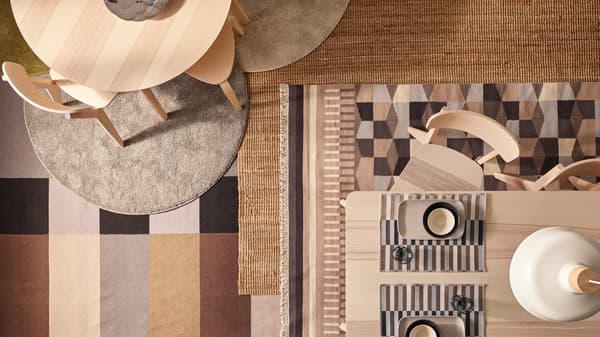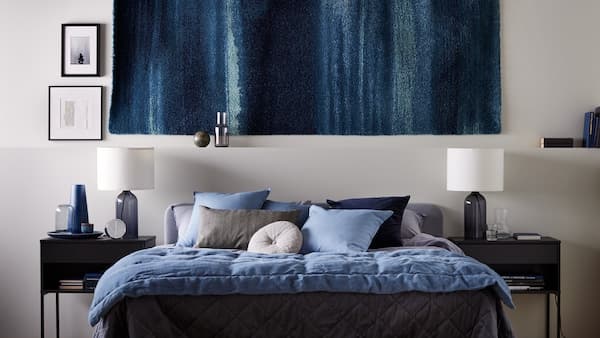A complete rug size guide
Rugs bring comfort, warmth, and style to any home. They soften your floors, help define zones in open spaces, reduce noise, and even protect surfaces. But choosing the right size is essential to make a room feel balanced. Use these simple tips to find a rug that fits your space perfectly.
How to choose the right rug for any room
How to choose a rug for the living room
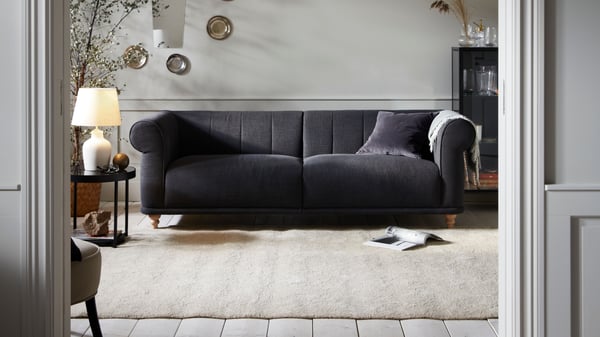
- Product information page
What type of rug is suitable for the living room?
The living room is where many various activities take place, and many different types of rugs can work. If you are looking for a cozy and comfortable feeling by the sofa, a slightly thicker rug is best. If you want extra softness, go for a rug with high pile.
What rug size to choose for your living room and how to place it
Length: When placing a rug under your sofa, choose one that extends beyond the sofa on both sides. This creates a more open, balanced look and frames the seating area with the sofa and coffee table.
Width: If you are using a large area rug (or combining several), the entire sofa can sit on the rug. Otherwise, aim to place about one-third of the sofa on the rug. This helps keep the rug in place and visually connects the furniture in the room.
Your ideal rug width will depend on your living room layout and how much of each piece of furniture you want on the rug. Whether you have a corner sofa, chaise, armchairs, or a loveseat, they should sit fully or partially on the rug without making the space feel crowded.
Tip! For larger sofas, consider the STOENSE rug, which can be combined seamlessly for wider coverage.
Living room rug size guide
Loveseats - Two-seater sofas
Sofas
Loveseats and sofas with chaise
Corner sofas
How to choose a rug for the dining room
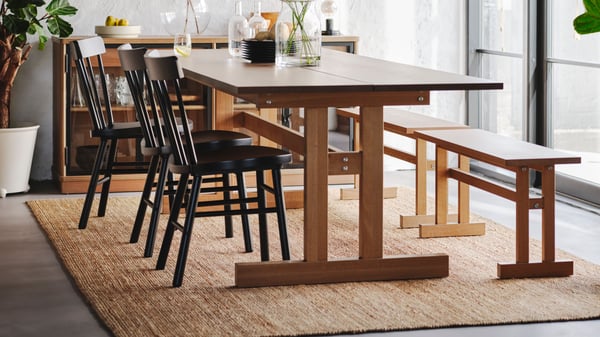
- Product information page
Choosing the best rug for under your dining table
The area under your dining table can get messy, with crumbs and spills a common problem. A flatwoven rug is ideal because crumbs won’t get trapped in the pile, chairs slide easily, and cleaning is simpler. Some IKEA rugs are even machine washable!
Tip! If you have small children, you can place a KOLON floor protector under the high chair, which is easy to wipe off.
What rug size to choose for your dining room and how to place it
Length: Choose a rug that is longer than your dining table. If you have chairs at each end, make sure the rug extends far enough so chairs can be pulled in and out without catching on the edges.
Width: Your rug should be wider than the table and chairs, even when the chairs are pulled out. A good rule of thumb is to add 60–80 cm to each side of the table. This prevents chairs from catching on the rug and keeps the space feeling balanced.
Dining room rug size guide
Dining table and 2 chairs
Dining table and 4 to 6 chairs
How to choose a rug for the bedroom
What type of rug is best for the bedroom?
A cooler bedroom can help you sleep better, but it also means cold floors. A large, soft pile rug adds warmth underfoot and gives your room that inviting, hotel-like feel.
Another option is to have a small area rug by the bedside, or a ULLERSLEV sheepskin. A bedroom rug also contributes to better sleep by collecting dust particles from the air, preventing dirt from getting into the bed, and reducing noise.
Tip! If you have under-bed storage drawers, a short pile or plain weave rug makes it easier to pull the drawers out.
How to place a rug under a bed, and what size to choose
Rug size and placement depend on where your bed sits in the room.
For a double bed, or a single bed centered in the room, you can place a rug fully or partially under the bed, covering the floor under the footboard and along the sides. Make sure there’s about 50 cm of rug at the sides so you have a soft surface underfoot when getting up.
Tip! For a larger area, the STOENSE rug can be combined seamlessly for extra coverage.
An alternative is to place smaller rugs at the sides of the bed. A good size for this is 80×150 cm.
Bedroom rug size guide
Twin bed
Full/Double, Queen, and King bed
How to choose a rug for the hallway or entryway
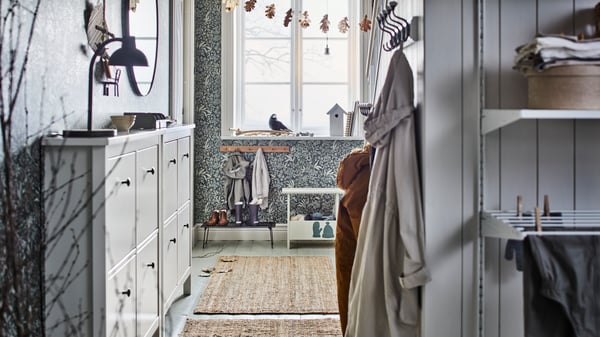
- Product information page
What kind of rug fits in the entryway?
The first answer is of course: doormats. A durable mat placed inside at the door protects the floor and collects gravel and dirt, so you don't have to vacuum the entryway as often as you would if you didn't have a doormat.
Depending on the size of your entryway, you can also have a runner further into the hallway. Smaller, narrower flat-woven rugs work well as hallway runners. They are easy to lift and shake off and vacuum. Since they are lighter and smaller, you can change them out seasonally to update your space.
Hallway rug size guide
How to choose a rug for an outdoor space
- Product information page
What kind of rug works outside?
An outdoor rug can add a more personal and cozier feel, even on a balcony and terrace. Especially if you have a hard and cold floor of stone or concrete. Just remember to choose a rug designed for outdoor use so it can withstand sun, rain, and snow.
Since outdoor rugs are extra hardwearing, they are also well-suited for certain indoor spaces, like under the dining table, where spills and wear are common.
Outdoor rug size guide

All you need to know before choosing a rug
It's important to also think about the material, style, and how to clean and care for your rug so you're sure to choose the right fit for your space.
What material should I choose for my rug?
Rugs are available in many different materials. What you choose depends partly on where it will be used – whether the rug is to be placed in the bedroom or a more frequently used part of the home. Of course, your style preferences also matter if you choose something like a handmade rug in wool or an area rug with a long pile made of recycled polyester.
Natural fibres
Jute, sisal, seagrass, and other natural fibres are hardwearing and recyclable materials that add a beautiful texture and warm feel to rugs. These rugs often have natural colour variations that make each rug unique. Natural fibres are not very good at repelling water, but stains can be removed with a little water and soap on a cloth.
Synthetic fibres
The advantage of a rug in synthetic fibre is that it’s hardwearing and doesn’t shed lint. It’s also quite stain-resistant and easy to clean. This is why durable and easy-care synthetic fibres are optimal for rugs placed in areas with a lot of traffic, like the kitchen, children’s room and hallway – and for outdoor rugs. Common synthetic materials are polypropylene, polyester, and nylon.
How do I clean and care for my rug?
The lifespan of a rug depends a lot on how well you take care of it. Most rugs, especially if they are made of natural materials like wool or cotton, are happiest and last longer if they are not washed too often.
Vacuum your rug often
• Regular vacuuming, at least once a week, is good for the rug to prevent dust and dirt particles from entering and damaging the carpet fibres. Use the flat nozzle, not the brush, and vacuum at low power. If the rug has piles, finish by vacuuming in the direction that the piles lie.
• In rooms where the carpet is more exposed to dirt, such as hallways and kitchens, they may need to be vacuumed more often.
• Remember to also vacuum under the carpet from time to time, as a lot of dirt and grit can make its way down through the carpet.
Removing stains
Dry stains should be scraped gently towards the centre of the stain. Wet stains should not be rubbed, soak up the stain with paper towels or a damp white cloth before the stain penetrates too deeply into the rug.
Machine-wash when needed
Some rugs are designed to be machine washable, making them easy to keep clean and perfect for high-traffic areas or homes with children and pets.
• It is generally recommended to only wash a rug (if possible) when it can no longer be cleaned by vacuuming alone. Always follow the care instructions for water temperature and washing cycles to keep your rug looking its best.
• Even with washable rugs, vacuuming regularly is still recommended to remove dust and dirt before washing.
Rotate your rug regularly
• If the carpet is located in rooms where you often walk on it, you should rotate it regularly (or flip it over, if it is reversible). This will reduce wear and tear and make the carpet wear more evenly and last longer.
• Keep in mind that when moving the rug, you should avoid pulling only the edge of the carpet. The edge consists only of a single seam and can only withstand a certain load.
Keeping the rug fresh for longer
• Many rugs are the same on both sides, which means you can turn them over at regular intervals.
• A handmade or larger rug that is extra dirty should be washed by a professional dry cleaner. Avoid placing your rug in direct sunlight since this will bleach the rug.
Care of oriental rugs
A Persian carpet is durable and easy to maintain. With regular vacuuming, it can stay that way for a long time. If a Persian rug gets dirty or needs repair, we recommend hiring a professional carpet cleaner. Specialized equipment is required to properly clean this type of carpet without damaging it.
Anti-slip underlay
With one of our anti-slip underlays, STOPP or STOPP FILT, under the rug, it stays firmly in place when you vacuum. You also reduce the risk of tripping or slipping on the rug. The anti-slip underlay protects both the floor and the rug, and the rug will also feel a little softer to walk on if you choose STOPP FILT.
Find care instructions for your rug under the Product details and Material & care section of the product page.


